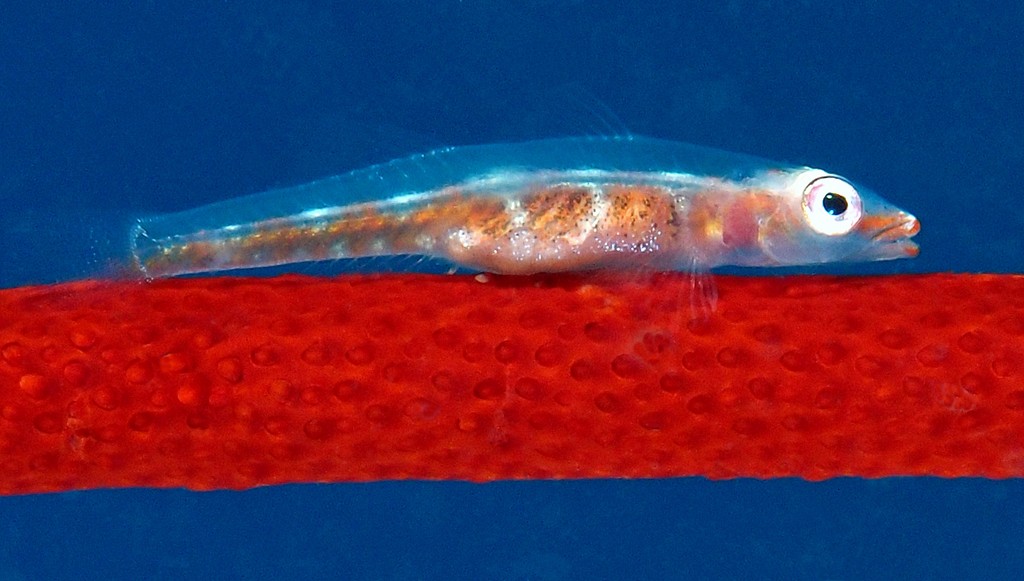BRYANINOPS LOKI - (LARSON, 1985)
Actinopterygii (Gigaclass) > Actinopteri (Class) > Teleostei (Subclass) > Gobiiformes (Order) > Gobioidei (Suborder) > Gobiidae (Family) > Gobiinae (Subfamily) > Bryaninops (Genus)
Loki whip-goby, White-line seawhip goby, Loki whip goby, Loki's goby, White-line Seawhip Goby, Hosogarasu haze, ホソガラスハゼ, 宽鳃珊瑚鰕虎鱼, 寬鰓珊瑚鰕虎魚,
Description
Dorsal spines (total): 6-7; Dorsal soft rays (total): 7-9; Anal spines: 1; Anal soft rays: 7-9. Scales usually extending forward to above pectoral-fin base, the longitudinal scale count 33-53 (mean scale count: 47); Body depth at origin of anal fin 10.5–17.8 % SL; Body progressively compressed posteriorly; Head width slightly greater than head depth; Snout short, the length equal to or less than orbit diameter; Gill opening extending forward to posterior margin of orbit; One or two canine teeth at side of lower jaw; Caudal fin truncate with rounded corners; Pelvic fins short, round, and cup-like; Pelvic spines short and fleshy. Max. length: 4.5 cm SL. Depth range: 6 - 45 m.
Color
Nape and body transparent dorsally with seven narrow red bars that broaden as they pass onto dusky golden ventral part of body (on some individuals, the red and gold tend to merge, making the bars indistinct); A white to pale yellow line visible dorsally on vertebral column.
Etymology
Bryaninops: from the former similar or related genus Bryanina now, Sicyopterus + from Ancient Greek, óps = eye, face, appearance.
Loki: named after the legendary Old Norse god Loki, who was a “rather enigmatic trickster,” presumably referring to its cryptic coloration, matching the gorgonian sea fans and whips on which it is most often found.
Original description: Bryaninops loki Larson, 1985 - Type locality: On dropoff halfway between Bird and South islands, Lizard Island, Great Barrier Reef, Australia, depth 15-16 meters.
Distribution
Red Sea, Indo-West Pacific: Chagos Archipelago east to Samoa and Line Islands, north to Ryukyu Islands, south to northern Australia and New Caledonia.
Biology
Inhabits reef walls and drop-offs with strong currents, often on inshore reefs in turbid waters. Lives on sea whips, gorgonian soft corals (such as Junceella, Ellisella and Subergorgia)and black corals (Antipathes).
Loki whip-goby, White-line seawhip goby, Loki whip goby, Loki's goby, White-line Seawhip Goby, Hosogarasu haze, ホソガラスハゼ, 宽鳃珊瑚鰕虎鱼, 寬鰓珊瑚鰕虎魚,
Description
Dorsal spines (total): 6-7; Dorsal soft rays (total): 7-9; Anal spines: 1; Anal soft rays: 7-9. Scales usually extending forward to above pectoral-fin base, the longitudinal scale count 33-53 (mean scale count: 47); Body depth at origin of anal fin 10.5–17.8 % SL; Body progressively compressed posteriorly; Head width slightly greater than head depth; Snout short, the length equal to or less than orbit diameter; Gill opening extending forward to posterior margin of orbit; One or two canine teeth at side of lower jaw; Caudal fin truncate with rounded corners; Pelvic fins short, round, and cup-like; Pelvic spines short and fleshy. Max. length: 4.5 cm SL. Depth range: 6 - 45 m.
Color
Nape and body transparent dorsally with seven narrow red bars that broaden as they pass onto dusky golden ventral part of body (on some individuals, the red and gold tend to merge, making the bars indistinct); A white to pale yellow line visible dorsally on vertebral column.
Etymology
Bryaninops: from the former similar or related genus Bryanina now, Sicyopterus + from Ancient Greek, óps = eye, face, appearance.
Loki: named after the legendary Old Norse god Loki, who was a “rather enigmatic trickster,” presumably referring to its cryptic coloration, matching the gorgonian sea fans and whips on which it is most often found.
Original description: Bryaninops loki Larson, 1985 - Type locality: On dropoff halfway between Bird and South islands, Lizard Island, Great Barrier Reef, Australia, depth 15-16 meters.
Distribution
Red Sea, Indo-West Pacific: Chagos Archipelago east to Samoa and Line Islands, north to Ryukyu Islands, south to northern Australia and New Caledonia.
Biology
Inhabits reef walls and drop-offs with strong currents, often on inshore reefs in turbid waters. Lives on sea whips, gorgonian soft corals (such as Junceella, Ellisella and Subergorgia)and black corals (Antipathes).
